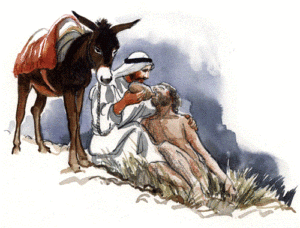
Which one was a neighbor? (Luke 10:25-37)
Pay attention to the dialogue between Jesus and the scholar of the law:
- Scholar of the law: “What must I do to inherit eternal life?”
- Jesus: “What is written in the law?”
- Scholar of the law: “You shall love the Lord, your God, with all your heart, with all your being, with all your strength, and with all your mind, and your neighbor as yourself.”
- Jesus: “Do this and you shall live.”
- Scholar of the law: “Who is my neighbor?”
- Jesus tells the parable of the Good Samaritan.
- Jesus: “Which of these three was neighbor to the robbers’ victim?”
- Scholar of the law: “The one who treated him with mercy.”
- Jesus: “Go and do likewise.”
3 points:
- The great reversal: the question “who is my neighbor” was reversed by Jesus to “which one of these three was neighbor to the robbers’ victim?” If you ask the question, “who is my neighbor?” It leaves the possibility that one can pick and choose who deserves to be your neighbor; but the question, “which one of these three was neighbor to the robbers’ victim” suggests that all three had a moral obligation to stop and help the robbers’ victim. Should the priest have stopped to help? Yes. Should the Levite have stopped to help? Yes. Should the Samaritan have stopped and helped? Yes. But only one of the three stopped and helped the robbers’ victim. Only one of the three was neighbor to the victim.
- The scholar of the law made himself the focus of attention by asking the two questions: “What must ‘I’ do to inherit eternal life?” and “Who is ‘my’ neighbor?” In order to inherit eternal life, the focus of attention must not be oneself but others, especially those who are in desperate need.
- The parable left no ambiguity as to which type of situation we have a moral obligation to help. A man was robbed, beaten and left half-dead by the road. If you happen to pass by someone in this situation, or similar to it, there is clearly a moral obligation for you to stop and help him.
This is a story of two high-school girls, one was pretty and the other was rather plain-looking. The pretty one was quite popular in school and a bit too friendly with the boys; she also bullied the other girl constantly, whether in person or in cyber-bullying. One day, the plain girl was walking her dog as she did everyday and they headed to the park. The dog kept pulling on the leash towards the bushes at the edge of the park. As she came closer to the bushes, she heard someone sobbing. She and the dog went over to the other side of the bushes and there she saw her. The girl who bullied her was lying on the ground; she was evidently beaten but there was something else – someone did something really bad to her. Without hesitation, the plain girl pulled out her cellphone and called her mom. Not long, the police and the ambulance came, and the girl was taken cared of. Now the plain girl could have thought ‘payback time’ and left the other girl, but she didn’t. She did the right thing and helped the other girl, even though she was her enemy.
In the parable of the Good Samaritan, Jesus told the scholar of the law to go and do likewise. In the same way, Jesus also tells us: “Go and do likewise.”